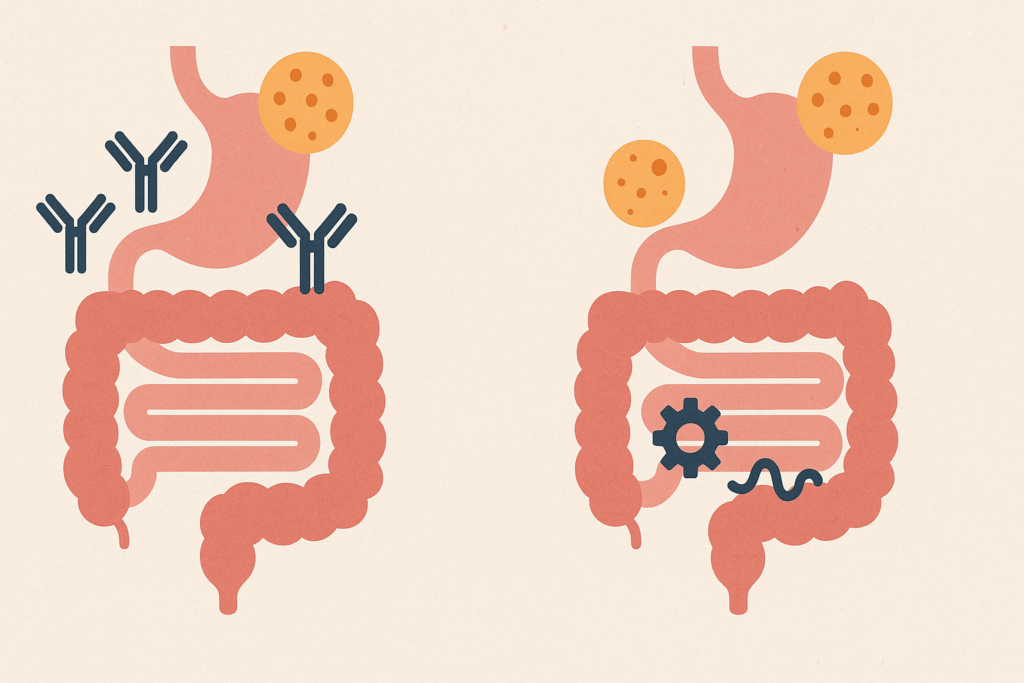Understanding how to use ‘food intolerance’ in a sentence goes far beyond grammar or semantics. It opens the door to clearer health communication, better patient advocacy, and a more nuanced appreciation of how diet-related reactions impact the body. In an age where nutrition and wellness have taken center stage in both personal health and clinical conversations, learning the language around food intolerance has become not only helpful but essential. The phrase itself appears simple, yet behind it lies a complex interplay of gastrointestinal symptoms, immune responses, and lifestyle changes that many people must navigate daily. This article is designed to serve both as an educational tool and a practical guide, especially for readers looking to understand or explain food intolerance in a clear, medically accurate way.
The need for a sentence example of food intolerance is particularly relevant for those who wish to describe symptoms accurately to healthcare professionals or articulate dietary challenges to others. When used correctly in context, this phrase can help demystify digestive issues, encourage timely diagnosis, and promote healthier food choices. With the rise of intolerance-related discussions across social media, medical blogs, and wellness literature, precise language is crucial. Misunderstandings can lead to self-diagnosis errors, delayed treatment, or even unnecessary dietary restrictions. That’s why this exploration of how to properly use food intolerance in a sentence is so timely and important.
You may also like: Macronutrients vs Micronutrients: What the Simple Definition of Macronutrients Reveals About Your Diet and Health

Defining Food Intolerance in Context
Before one can use a sentence for food intolerance effectively, it’s important to understand what food intolerance actually is. Unlike food allergies, which involve the immune system, food intolerances typically arise from the digestive system’s inability to properly process certain foods. Common examples include lactose intolerance, where the body lacks the enzyme lactase, and gluten intolerance, which can lead to symptoms like bloating, fatigue, and digestive distress. Importantly, food intolerance does not pose the same immediate risk of anaphylaxis that food allergies do, but it can still significantly impair quality of life.
Scientific definitions of food intolerance often refer to non-immunologic adverse reactions to food, which manifest in gastrointestinal symptoms such as gas, diarrhea, abdominal pain, or nausea. These reactions are usually dose-dependent, meaning they intensify with the amount of the offending food consumed. Because of this complexity, the phrase “food intolerance used in a sentence” must convey not just the existence of a dietary reaction, but also its underlying mechanism and consequences.
From a clinical standpoint, identifying food intolerance involves a combination of patient history, food diaries, and sometimes elimination diets or breath tests. It’s a process of exclusion, trial, and careful observation, which further underscores the importance of language when describing symptoms. When patients and providers can clearly communicate what “food intolerance” means in real-world contexts, the path to diagnosis becomes far smoother.

Why Language Matters in Describing Food Intolerance
The power of precise language in health communication cannot be overstated. Whether in a medical appointment, educational article, or support group, how we describe symptoms can influence diagnosis and treatment. This is why offering a clear sentence example of food intolerance can serve as more than just an academic exercise—it can become a tool for better self-advocacy. When someone is able to say, “I experience bloating and cramps whenever I eat dairy, which is consistent with lactose intolerance,” they’re providing actionable information.
In contrast, vague statements like “I think food makes me feel bad” lack the specificity needed for clinical evaluation. This is especially important because many symptoms of food intolerance overlap with those of irritable bowel syndrome, small intestinal bacterial overgrowth (SIBO), or even stress-related gut disturbances. A sentence for food intolerance should help pinpoint the cause of symptoms by referencing both the food trigger and the physical response.
Moreover, precision in language helps reduce stigma. For years, food intolerances were dismissed as psychosomatic or exaggerated. By using medically grounded terminology in everyday communication, patients can legitimize their experiences. Saying “This is a food intolerance” rather than “I just don’t like how this food makes me feel” signals a real, physiological issue deserving of recognition.
Sentence Examples that Illustrate Food Intolerance Clearly
To better grasp how to use food intolerance in a sentence, consider the following well-structured examples. Each sentence highlights a specific trigger, describes a symptom, and frames the situation in a way that is medically informative.
“After eating pasta, she felt bloated and fatigued, prompting her doctor to suggest that it might be a gluten-related food intolerance.”
This sentence offers a concise yet complete description, integrating both the suspected food and the bodily response. It allows for a deeper understanding of the condition and its context.
“He avoided milk for years due to consistent abdominal cramping, which was eventually diagnosed as lactose intolerance—a common type of food intolerance.”
Here, the sentence functions not only as an example but also as an educational tool, demonstrating how symptoms can lead to diagnosis. This type of food intolerance used in a sentence helps reinforce both medical and layperson understanding.
“A registered dietitian explained that while allergies involve the immune system, a food intolerance typically causes digestive discomfort without immune activation.”
This sentence offers clarity by distinguishing between two often-confused conditions. It also emphasizes the role of expert guidance, aligning with the EEAT framework by showing how expert opinion can guide interpretation.
“Symptoms like bloating, nausea, or headaches after eating specific foods may indicate a food intolerance, especially if they resolve when the food is removed from the diet.”
By using common symptoms and a cause-effect pattern, this sentence provides practical insight that readers can apply to their own experiences. It makes the abstract concept of intolerance feel more tangible.
“In many cases, identifying a food intolerance used in a sentence can help patients explain their condition more confidently to healthcare providers and family members.”
This meta-example demonstrates the utility of language itself, reflecting the article’s core objective. It also underscores the empowering nature of effective communication.

Practical Scenarios Where Food Intolerance Descriptions Matter
There are several scenarios where knowing how to use food intolerance in a sentence can make a real difference. One common situation is during medical consultations, where patients need to articulate their symptoms clearly. Instead of saying “I think bread gives me issues,” a more helpful sentence might be, “Whenever I eat bread, I experience bloating and gas, which makes me suspect a food intolerance to gluten.” This structured explanation provides clinicians with both a suspected trigger and associated symptoms, improving diagnostic accuracy.
Another context is in educational environments, such as classrooms or nutrition workshops. When students are asked to provide a sentence example of food intolerance, they benefit from tying together knowledge of digestive physiology, dietary patterns, and common symptomatology. This enhances both their academic understanding and real-world communication skills.
Family gatherings, social outings, or meal planning are also critical arenas. Saying, “I can’t eat onions because I have a food intolerance that causes severe bloating,” is far more helpful than simply refusing food without explanation. It encourages empathy and reduces awkwardness in group settings. Furthermore, such statements normalize discussions about dietary needs, fostering inclusivity.

The Science Behind Food Intolerance: Why It Happens
To further strengthen your ability to use food intolerance in a sentence, understanding the physiological basis is helpful. Most food intolerances arise from enzyme deficiencies, such as a lack of lactase for lactose intolerance or reduced activity of alcohol dehydrogenase in alcohol sensitivity. Others may involve chemical sensitivities—histamines in wine or caffeine in coffee can provoke adverse reactions in sensitive individuals.
These responses are typically dose-dependent, meaning that small amounts may be tolerated while larger amounts cause symptoms. This differentiates them from food allergies, which can be triggered by even trace exposures. Because food intolerance operates along a spectrum, it’s important that any sentence for food intolerance convey variability and context. For example, one might say, “I have a mild food intolerance to dairy; I can tolerate small amounts of cheese but not a glass of milk.”
Understanding this gradation allows patients to make informed dietary decisions and helps healthcare providers tailor recommendations. It also reinforces that food intolerance is not simply a preference or trend but a biological response with underlying causes. A well-formed sentence should reflect this nuance.

Psychosocial Impacts of Misunderstood Intolerances
Miscommunication about food intolerance can have broader social and psychological effects. Many individuals with food intolerance report feeling dismissed, misunderstood, or even ridiculed. Phrases like “Oh, you’re just being picky” or “That’s not a real issue” can undermine someone’s lived experience. This is where a clear and medically grounded sentence example of food intolerance can be transformative.
By offering structured, evidence-based explanations, individuals can gain confidence in asserting their needs. For instance, saying “This isn’t a preference; my food intolerance causes symptoms like migraines and digestive upset when I eat chocolate” shifts the narrative. It invites understanding and positions the speaker as informed rather than dramatic.
In work environments or schools, written documentation that includes a food intolerance used in a sentence can support accommodations. This might appear in a doctor’s note, a student health plan, or dietary restrictions for catered events. Clarity in language enables policy-level support, helping to create more inclusive environments.

Bringing EEAT into the Conversation
The EEAT framework—Experience, Expertise, Authoritativeness, and Trustworthiness—is essential in health communication, especially when the goal is to inform and empower readers. When we offer a well-structured sentence for food intolerance, we’re not just providing grammar help; we’re reinforcing reliable knowledge. For example, sentences grounded in lived experience (“I noticed that after every meal containing onions, I developed painful bloating, leading my doctor to identify a food intolerance”) reflect the ‘experience’ component.
When those sentences are backed by professional evaluation or nutritional science, they also embody ‘expertise’ and ‘authoritativeness.’ The inclusion of accurate information, such as the difference between intolerance and allergy, elevates trustworthiness. This is why the way we phrase our descriptions matters so much. It’s not only about being correct but being credible.
Even health websites, journals, and patient education materials benefit from sentence clarity. When a food intolerance used in a sentence appears in official resources, it sets a precedent for how patients should communicate. It also signals to readers that the information is vetted and valuable.
Why Learning to Talk About Food Intolerance Helps Everyone
When more people understand how to articulate food intolerance clearly, the benefits extend beyond individual diagnosis. Nutritionists can design better meal plans, chefs can accommodate dietary needs, and public health initiatives can craft more effective messaging. Every time a sentence example of food intolerance is shared in the right context, it strengthens the collective ability to talk about digestive health.
Children can be taught to recognize and verbalize symptoms, reducing anxiety and improving safety. Caregivers and family members who learn to distinguish between preference and intolerance can offer better support. And patients who know how to say, “This is a food intolerance and not a fad diet,” are better equipped to protect their health and wellbeing.
Ultimately, the language of food intolerance—when used accurately—becomes a bridge between lived experience and scientific validation. It closes the gap between symptom and solution, helping to create a culture of understanding, support, and informed choice.
Frequently Asked Questions (FAQ): How to Use ‘Food Intolerance’ in a Sentence
1. Why is it important to learn how to use ‘food intolerance’ in a sentence accurately? Understanding how to use ‘food intolerance’ in a sentence is crucial not only for clear communication but also for promoting personal health advocacy. When someone can articulate their dietary restrictions or symptoms effectively, they improve their chances of receiving accurate diagnoses and timely care. For instance, a strong sentence example of food intolerance might be: “After consuming dairy, I experience migraines and nausea, which my nutritionist identified as a food intolerance.” This kind of clarity removes ambiguity and helps healthcare providers take informed action. Learning the correct usage also empowers individuals to educate others and reduce stigma around invisible digestive conditions.
2. How can I explain my symptoms in a sentence without sounding overly clinical or vague? The key is to balance specificity with conversational language. A well-structured sentence for food intolerance should mention the triggering food and the consistent symptom it causes. For example, instead of saying, “I don’t feel good after eating,” you might say, “Every time I eat onions, I experience bloating and discomfort, which points to a possible food intolerance.” This not only sounds natural but also conveys important information. You don’t need to sound like a doctor—just focus on being descriptive and honest about your experiences. The right sentence can open doors to better support and understanding.
3. Can you give an example of a professional context where using ‘food intolerance’ in a sentence is helpful? Absolutely. In workplace settings, school environments, or during travel planning, being able to use food intolerance in a sentence clearly can prevent misunderstandings and ensure proper accommodations. A polished example might be: “Due to a food intolerance, I cannot consume meals containing gluten and would appreciate a suitable alternative during the conference luncheon.” This sentence example of food intolerance is respectful, informative, and allows others to respond appropriately. It avoids ambiguity while maintaining professionalism, which is especially important in shared or formal settings.
4. How can educators or clinicians help children describe their food intolerances effectively? Helping children form a simple but meaningful sentence for food intolerance empowers them to advocate for their needs early. Clinicians and educators can teach young students to say, “I get a stomachache when I drink milk because I have a food intolerance.” Practicing these phrases in a safe environment helps children become confident in social and medical situations. Additionally, incorporating the food intolerance used in a sentence during lessons or role-playing exercises fosters empathy and awareness among peers. Early language skills around health can lead to a lifetime of improved communication and self-care.
5. What are some advanced techniques for writing about food intolerance in academic or wellness publications? When writing for scholarly or health-focused publications, integrating a sentence for food intolerance requires clarity, context, and authority. Instead of simply stating, “People may have food intolerances,” one might write, “Clinical studies show that individuals with histamine intolerance often report symptoms such as headaches and hives after consuming fermented foods, a reaction best described as a non-immunological food intolerance.” This approach ensures that the food intolerance used in a sentence is both medically valid and stylistically suitable for an educated readership. Writers should aim to support their statements with evidence and case examples to align with EEAT principles.
6. Are there cultural or psychological factors that influence how people describe food intolerance? Yes, cultural norms and emotional responses can shape how openly or accurately someone expresses food-related health issues. In some cultures, there may be reluctance to discuss bodily symptoms, making it harder for individuals to verbalize their food intolerance. In such cases, having access to structured examples—such as a well-modeled sentence example of food intolerance—can be incredibly helpful. Psychological factors like fear of judgment or past dismissal by healthcare professionals may also cause people to downplay their symptoms. Offering supportive, stigma-free environments where individuals can practice using food intolerance in a sentence can help shift this dynamic.
7. How can caregivers or family members support loved ones who struggle to describe their food intolerances? Family members can play a vital role by helping loved ones rehearse or write down their symptoms in sentence form. For example, guiding someone to say, “I experience nausea and bloating when I eat soy, which is likely due to a food intolerance,” provides both validation and practical structure. Encouraging the repeated use of food intolerance used in a sentence reinforces the legitimacy of their experience and builds communication skills. Additionally, caregivers can model this language when speaking to medical professionals or during shared meals, further reducing barriers to understanding. Supportive communication fosters both emotional and physical health.
8. Can sentence structure affect how seriously food intolerances are taken in clinical settings? Yes, the way you frame your sentence for food intolerance can significantly affect the perception of urgency or legitimacy. A vague statement like, “Certain foods don’t sit well with me,” may not prompt further inquiry. In contrast, “I’ve tracked my symptoms and consistently feel abdominal pain and fatigue within two hours of eating wheat, suggesting a food intolerance,” offers a well-documented basis for clinical exploration. Such sentence examples of food intolerance reflect self-awareness, reliability, and observational precision—all valuable qualities in patient-provider communication. It shows that the individual has done their part, inviting a more engaged response from the clinician.
9. What emerging tools or technologies help people document and express their food intolerances more effectively? Mobile apps and digital health journals now allow users to log meals, symptoms, and timing, generating patterns that can be summarized in sentences. These tools can even suggest phrasing, such as a ready-made sentence for food intolerance like, “Based on the past three weeks of logs, I experience discomfort after consuming nightshade vegetables, possibly indicating a food intolerance.” These summaries can then be shared with healthcare providers or used in consultations. Additionally, voice-to-text features offer accessibility for individuals with learning disabilities or language barriers. As more platforms prioritize customization, users are increasingly empowered to describe their food intolerance in a sentence that suits their experience.
10. How can the use of ‘food intolerance’ in a sentence evolve in the future of digital health and communication? As artificial intelligence and personalized nutrition services continue to expand, the use of food intolerance in a sentence may become more predictive and data-driven. Digital assistants might prompt users with phrases like, “Would you like to log this as a possible food intolerance reaction?” thereby integrating language education into real-time health tracking. Over time, users will be able to generate sentence examples of food intolerance that reflect both immediate experiences and long-term health patterns. This evolution supports proactive care and reduces the emotional burden of explaining symptoms repeatedly. Ultimately, technology will help individuals build a nuanced language of health that is as intelligent as it is empathetic.
Conclusion: Mastering the Language of Food Intolerance for Better Health
In the journey toward nutritional awareness and digestive wellness, knowing how to use ‘food intolerance’ in a sentence is more than a linguistic skill—it’s a health strategy. When you can clearly describe symptoms, identify triggers, and communicate with both professionals and peers, you empower yourself to make better decisions. A well-crafted sentence example of food intolerance is not just an academic exercise; it’s a real-world tool that improves understanding and fosters empathy.
Whether you’re using a sentence for food intolerance in a medical setting, writing it in a blog post, or explaining your needs at a dinner table, your words matter. The clarity and precision of your communication can directly influence how seriously your concerns are taken and how effectively they are addressed. And when you integrate a food intolerance used in a sentence that reflects both scientific understanding and personal experience, you contribute to a broader culture of trust and health literacy.
Through this article, we’ve shown not only what food intolerance is but also how to describe it accurately and effectively. We’ve illustrated the physiological roots, the real-life applications, and the social implications of misunderstood dietary needs. Most importantly, we’ve emphasized how the right sentence—backed by knowledge, context, and care—can become a catalyst for improved health outcomes and a more inclusive dialogue around nutrition.
So next time you need to explain a food reaction, remember: words matter. And now, you know exactly how to use them.


